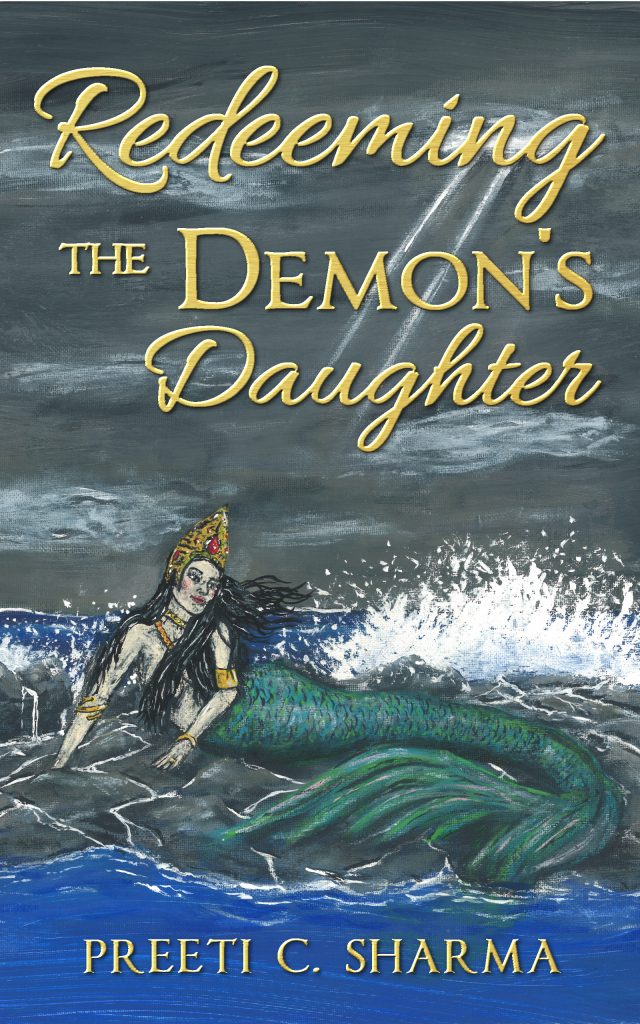Relatives express shock when I tell them I wrote a short story about a section of Hindu epic, the Ramayana, in Redeeming the Demon’s Daughter. Particular characters I addressed in the story, like Rama and Hanuman, are commonly known in other parts of South Asia that practice Hinduism. But among Indian Hindus, the character of Suvarnamatsya, a mermaid, remains relatively unknown. Many forget the critical role of mermaids in the Ramayana.
Certainly people don’t connect the mermaids with the epic’s main villain, the ten-headed demon Ravana. The leader of the mermaids, Suvarnamatsya, is one of his many daughters.
Mermaids in the Ramayana
Suvarnamatsya is a mermaid and the leader of her clan. Their efforts stymie those of Hanuman’s army as they attempt to build a bridge to cross the ocean to attack Ravana and rescue Sita from his clutches. Eventually, Hanuman convinces Suvarnamatsya to let her mermaids help his army so that Rama can defeat Ravana.
The Ramayana couldn’t have proceeded as we know it if the mermaids didn’t aid Hanuman. The mermaids helped Hanuman’s army build what is now known as Adam’s Bridge (AKA Rama’s Bridge AKA Rama Setu). Geologists believe that this limestone feature stood above sea level until the fifteenth century.

Relationships in the Ramayana
Sita is the unfortunate heroine of the Ramayana. A damsel in distress for much of the story, Sita’s role as the kidnapped wife of Rama allows her husband to fulfill his calling. Rama goes to battle with Ravana in an epic battle of good over evil to save her.
However, no one questions the relationship between Rama and Sita, which forms the foundation of any retelling of the Ramayana. Things get interesting when you look at Suvarnamatysa, who apparently has a child out of wedlock with Hanuman.
When I was first planning this story, Hanuman seems like the bad guy in all of this. After all, he abandoned the mother of his unborn child without a second thought to invade Ravana’s kingdom.
Hanuman in Hinduism
However, in Hindu mythology, Hanuman is the ultimate good guy and the truest of devotees. It would have been untrue to Hanuman’s character to suggest otherwise in my short story.
When considering the different types of love in Hinduism, Hanuman is famous for bhakti. There is a popular story where Sita presents Hanuman with a priceless necklace. He proceeds to destroy it because none of the gems contain Rama’s name or image. When some smarty-pants then asks why he maintains his own body, Hanuman tears open his chest to show that Rama (and Sita) reside in his heart.

Hanuman as a Father
Later in the Ramayana, Hanuman comes face-to-face with his grown son, Macchanu (AKA Makardhwaja). But they don’t recognize each other since Hanuman never knew he existed. I give my version of these events in Redeeming the Demon’s Daughter based on what the epics all seem to agree on. They are about to go to battle but first decide to share introductions. It warmed my heart to see that
1) Hanuman doesn’t want to hurt his son,
2) he is shocked to discover this child, and
3) he tries to do the right thing by his son and they appear to part on good terms.
Nonetheless, it bothers me that Hanuman set a bunch of events into action but then seems to have left his son after giving him a job and acknowledging him. I could imagine a modern-day angsty story about this son raised by foster parents who nobody believes has had a rough childhood because his dad is Such A Good Guy™.
His choices regarding Suvarnamatsya or Macchanu just don’t align with the image of Hanuman as a wise and devoted follower of Rama. In Hindu tradition, Rama is possibly the first major figure to only have one wife and remain faithful to her.
All the stories agree that Macchanu’s mother left him on the beach to be raised by her father’s brother. My need to find an explanation for this troubling event inspired Redeeming the Demon’s Daughter in the first place. Imagine my excitement learning about mermaids in the Ramayana and in Hindu tradition!
Differences in Hindu Mythology Across Asia
In Indian mythology, Hanuman is sometimes described as a life-long celibate. In other versions, he goes on to marry someone but does not have children.
As with many other miraculous births in Indian Hindu epics, they justified the birth of this son of Hanuman like so:
- A drop of Hanuman’s sweat falls into the ocean
- A crocodile possibly then swallowed it
- Suvarnamatsya somehow manages to birth a child from this droplet
(Well, I guess it must have been a drop of something…)
The Thai version of the Ramayana describes Hanuman as distinctly more flirtatious. It indicates that Hanuman and Suvarnamatsya were lovers who parted. There’s also another story that Hanuman seduced Ravana’s consort. Her chastity had formed Ravana’s last protection. When she fell to Hanuman’s charms, Rama finally defeated her husband.
Yet none of the stories I found in my research disputes that Suvarnamatsya loved Hanuman. Of course, none of these stories ever followed through on what happened to her after the events surrounding Adam’s Bridge, either. The mermaids fulfilled their role in the Ramayana and then disappear from the epic.

All I can conclude from these stories is that Hindus seem very uptight about the possibility of their gods consorting with anyone. Sure makes you wonder how a country with over a billion people got that way…

so this means mermaids do exists and it is also mentioned in Mahabharata …
more info., please
You can look at the Thai and Vietnamese versions of the Ramayana. I also tell the story of Ravana’s daughter, uncovered by my research in the short story, “Redeeming the Demon’s Daughter”, which is available on Amazon.